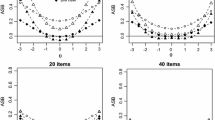Abstract
The option characteristic curve, the relation between ability and probability of choosing a particular option for a test item, can be estimated by nonparametric smoothing techniques. What is smoothed is the relation between some function of estimated examinee ability rankings and the binary variable indicating whether or not the option was chosen. This paper explores the use of kernel smoothing, which is particularly well suited to this application. Examples show that, with some help from the fast Fourier transform, estimates can be computed about 500 times as rapidly as when using commonly used parametric approaches such as maximum marginal likelihood estimation using the three-parameter logistic distribution. Simulations suggest that there is no loss of efficiency even when the population curves are three-parameter logistic. The approach lends itself to several interesting extensions.
Similar content being viewed by others
References
Azzalini, A., Bowman, A. W., & Härdle, W. (1989) On the use of nonparametric regression for model checking.Biometrika, 76, 1–11.
Barry, D. (1986). Nonparametric Bayesian regression.Annals of Statistics, 14, 934–953.
Becker, R. A., Chambers, J. M. & Wilks, A. R. (1988).The new S language. Pacific Grove, CA.: Wadsworth & Brooks/Cole.
Bock, R. D., & Aitkin M. (1981). Marginal maximum likelihood estimation of item parameters: Application of an EM algorithm.Psychometrika, 46, 443–459.
Bock, R. D., & Lieberman, M. (1970). Fitting a response model forn dichotomously scored items.Psychometrika, 35, 179–197.
Buja, A., Hastie, T., & Tibshirani, R. (1989). Linear smoothers and additive models (with discussion).Annals of Statistics, 17, 453–555.
Copas, J. B. (1983). Plottingp againstx.Applied Statistics, 32, 25–31.
Craven, P., & Wahba, G. (1979). Smoothing noisy data with spline functions.Numerische Mathematik, 31, 377–403.
Cressie, N., & Holland, P. W. (1983). Characterizing the manifest probabilities of latent trait models.Psychometrika, 48, 129–142.
Drasgow, F., Levine, M. V., Williams, B., McLaughlin, M. E., & Candell, G. L. (1989). Modeling incorrect responses to multiple-choice items with multilinear formula score theory.Applied Psychological Measurement, 13, 285–299.
Eubank, R. L. (1988).Spline smoothing and nonparametric regression. New York: Marcel Dekker.
Gasser, T., Müller, H. G., & Mammitzsch, V. (1985). Kernels for nonparametric curve estimation.Journal of the Royal Statistical Society, Series B, 47, 238–252.
Härdle, W. (1987). Resistant smoothing using the fast Fourier transform.Applied Statistics, 36, 104–111.
Härdle, W. (1991).Smoothing techniques with implementation in S. New York: Springer-Verlag.
Hastie, T., & Tibshirani, R. (1986). Generalized additive models.Statistical Science, 1, 297–318.
Hastie, T., & Tibshirani, R. (1987). Generalized additive models: Some applications.Journal of the American Statistical Association, 82, 371–386.
Levine, M. V. (1984).An introduction to multilinear formula score theory (Measurement Series 84-5). Champaign, IL: University of Illinois, Department of Educational Psychology, Model-Based Measurement Laboratory.
Levine, M. V. (1985). The trait in latent trait theory. In D. J. Weiss (Ed.),Proceedings of the 1982 item response theory/computerized adaptive testing conference. Minneapolis, MN: University of Minnesota, Department of Psychology, Computerized Adaptive Testing Laboratory.
Lewis, C. (1986). Test theory andPsychometrika: The past twenty-five years.Psychometrika, 51, 11–22.
Lord, F. M. (1980).Applications of item response theory to practical testing problems. Hillsdale, NJ: Lawrence Erlbaum.
Lord, F. M., & Novick, M. R. (1968). Statistical theories of mental test scores. Reading, MA: Addison-Wesley.
Lord, F. M., & Pashley, P. J. (1988).Confidence bands for the three-parameter logistic item response curve (Research Report No. 88-67). Princeton, NJ: Educational Testing Service.
Mislevy, R. J., & Bock, R. D. (1982).BILOG: Item analysis and test scoring with binary logistic models [Computer program]. Mooresville, IN: Scientific Software.
Mokken, R. J. (1971).A theory and procedure of scale analysis. The Hague: Mouton.
O'Sullivan, F., Yandell, B. S., & Raynor, W. J. Jr. (1986). Automatic smoothing of regression functions in generalized linear models.Journal of the American Statistical Association, 81, 96–103.
Press, W. H., Flannery, B. P., Teukolsky, S. A., & Vetterling, W. T. (1986).Numerical recipes: The art of scientific computing. Cambridge: Cambridge University Press.
Ramsay, J. O. (1988). Monotone regression splines in action (with discussion).Statistical Science, 3, 425–461.
Ramsay, J. O. (1989). A comparison of three simple test theory models.Psychometrika, 54, 487–499.
Ramsay, J. O., & Abrahamowicz, M. (1989). Binomial regression with monotone splines: A psychometric application.Journal of the American Statistical Association, 84, 906–915.
Ramsay, J. O., & Winsberg, S. (1991). Maximum marginal likelihood estimation for semiparametric item analysis.Psychometrika, 56, 365–379.
Samejima, F. (1979).A new family of models for the multiple choice item (Research Report No. 79-4). Knoxville, TN: University of Tennessee, Department of Psychology.
Samejima, F. (1981).Efficient methods of estimating the operating characteristics of item response categories and challenge to a new model for the multiple-choice item. Unpublished manuscript, University of Tennessee, Department of Psychology.
Samejima, F. (1984).Plausibility functions of Iowa Vocabulary Test items estimated by the simple sum procedure of the conditional P.D.F. approach (Research Report No 84-1). Knoxville, TN: University of Tennessee, Department of Psychology.
Samejima, F. (1988).Advancement of latent trait theory, Unpublished manuscript, University of Tennessee, Department of Psychology.
Silverman, B. (1986).Density estimation for statistics and data analysis. London: Chapman and Hall.
Thissen, D., & Wainer, H. (1982). Some standard errors in item response theory.Psychometrika, 47, 397–412.
Wahba, G. (1990).Spline models for observational data. Philadelphia: Society for Industrial and Applied Mathematics.
Wand, M. P., & Schucany, W. R. (1990). Gaussian-based kernels.Canadian Journal of Statistics, 18, 197–204.
Wingersky, M. S., Patrick, R., & Lord, F. M. (1988). LOGIST users guide. Princeton, NJ: Educational Testing Service.
Winsberg, S., & Ramsay, J. O. (1980). Monotonic transformations to addivity using splines.Biometrika, 67, 669–674.
Winsberg, S., & Ramsay, J. O. (1983). Monotonic spline transformations for dimension reduction.Psychometrika, 48, 403–423.
Author information
Authors and Affiliations
Additional information
The author wishes to acknowledge the support of the National Sciences and Engineering Research Council of Canada through grant A320 and the support of Educational Testing Service during his leave there.
Rights and permissions
About this article
Cite this article
Ramsay, J.O. Kernel smoothing approaches to nonparametric item characteristic curve estimation. Psychometrika 56, 611–630 (1991). https://doi.org/10.1007/BF02294494
Received:
Revised:
Issue Date:
DOI: https://doi.org/10.1007/BF02294494




